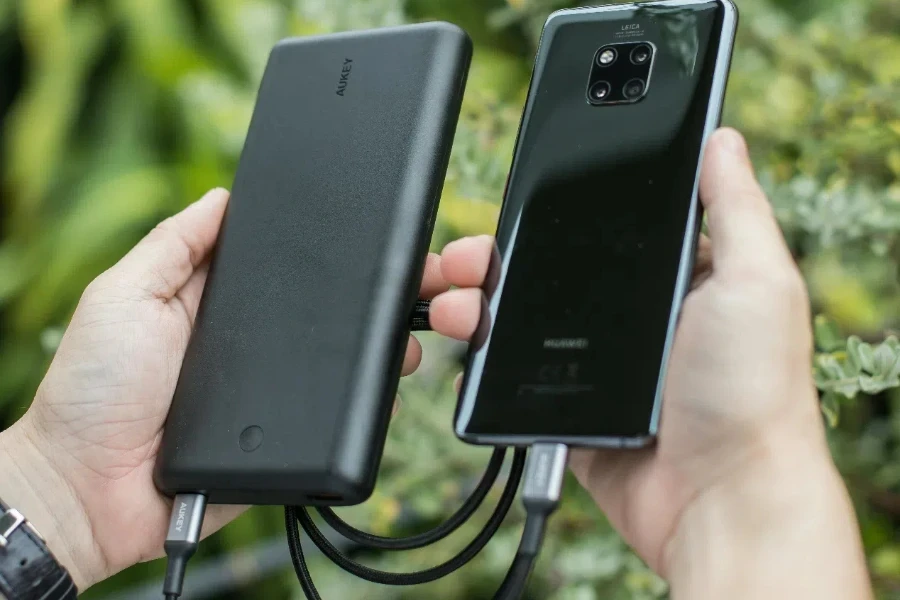In 2025, the market for portable battery chargers is booming with advancements in technology and increased demand for mobile power solutions. This article provides an in-depth analysis of critical factors such as battery capacity, charging speed, compatibility, and safety features. It aims to offer valuable insights and assistance to professional buyers, ensuring informed purchasing decisions in the ever-evolving global market.
Table of Contents:
– Understanding the Global Demand for Portable Battery Chargers
– Consumer Demographics and Usage Patterns
– Key Technical Specifications to Consider
– Evaluating Design and Portability
– Assessing Brand Reputation and Customer Reviews
Understanding the Global Demand for Portable Battery Chargers

Current Market Size and Growth Projections
The global market for portable battery-powered products, including portable battery chargers, was worth approximately USD 1.5 trillion in 2023. This market is projected to grow at a compound annual growth rate (CAGR) of 7.1%, reaching USD 2.4 trillion by 2030, according to Research and Markets. The increasing reliance on mobile devices and the need for on-the-go power solutions are significant drivers of this growth. Technological advancements in battery chemistry, such as the development of solid-state batteries, are enhancing the energy density and safety profiles of these devices.
The portable battery charger market is also benefiting from the trend towards miniaturization, which allows for smaller, lighter, and more powerful devices. This trend is expanding the potential applications of portable battery chargers in wearable technology and medical devices. Additionally, the integration of Internet of Things (IoT) capabilities is facilitating smarter and more connected user experiences, further driving market growth. Advances in charging technologies, including wireless and fast charging, are making portable devices more practical for everyday use.
Key Markets and Regional Preferences
The United States and China are key markets for portable battery chargers, with the U.S. market estimated at USD 395.7 billion in 2023. China is forecasted to grow at an impressive CAGR of 10.5%, reaching USD 574.2 billion by 2030, as reported by Research and Markets. The demand in these regions is driven by high smartphone penetration rates and the increasing adoption of portable electronic devices. In the U.S., the rise in remote working has led to greater reliance on portable devices that support a mobile office setup.
Other significant markets include Japan, Canada, Germany, and the Asia-Pacific region. These regions are experiencing growth due to the increasing popularity of personal health and fitness monitoring devices, which require continuous power supply. The Asia-Pacific region, in particular, is seeing a surge in demand for portable battery chargers due to the growing urban population and increasing disposable incomes. Government initiatives aimed at boosting literacy and job opportunities are also contributing to market expansion in these regions.
Emerging Trends in Consumer Preferences
One of the emerging trends in consumer preferences is the increasing demand for seamless connectivity across devices. Consumers are looking for portable battery chargers that offer efficient and reliable power solutions for their smartphones, tablets, and other gadgets. This demand is fostering innovations in battery efficiency and device interoperability. According to Research and Markets, the trend towards sustainability is also influencing consumer preferences, with a growing emphasis on energy-efficient, durable, and recyclable devices.
Another notable trend is the rising popularity of compact and lightweight designs in portable battery chargers. Consumers are prioritizing portability and ease of carrying these devices, which is driving the demand for smaller and more efficient chargers. The increasing adoption of smart home devices, such as smart speakers and security cameras, is also driving the need for reliable charging solutions. Wall chargers and power banks are becoming essential accessories for powering these devices efficiently, ensuring continuous functionality even in areas where wall outlets are inaccessible.
Consumer Demographics and Usage Patterns

Demographic Breakdown of Portable Battery Charger Users
The demographic breakdown of portable battery charger users reveals a diverse user base, with significant adoption among young adults and professionals. According to Research and Markets, the urban population growth worldwide is driving substantial demand for advanced mobile accessories, including portable battery chargers. Young adults, particularly those aged 18-35, are the primary users of these devices, as they are more likely to own multiple electronic gadgets and have active lifestyles that require reliable on-the-go charging solutions.
Professionals who frequently travel for business are also significant users of portable battery chargers. The increasing disposable incomes and declining smartphone prices globally are contributing to a surge in demand for these accessories among this demographic. Additionally, the rise in remote working has led to greater reliance on portable devices that support a mobile office setup, further driving the demand for portable battery chargers among professionals.
Common Usage Scenarios and Applications
Portable battery chargers are commonly used in various scenarios, including travel, commuting, and outdoor activities. These chargers allow users to maintain their electronics’ battery life while on the move, enhancing productivity and connectivity. According to Research and Markets, the versatility of portable battery chargers ensures that smartphones, tablets, and other gadgets remain powered throughout the day, making them essential accessories for modern consumers seeking uninterrupted device usage.
Another common application of portable battery chargers is in the context of personal health and fitness monitoring. The increasing popularity of wearables that offer continuous health tracking is boosting demand for portable battery chargers. These devices require reliable power solutions to ensure they remain operational throughout the day. Additionally, the integration of IoT capabilities in smart home devices is driving the need for versatile and dependable charging solutions, such as wall chargers and power banks, to power these devices efficiently.
Key Technical Specifications to Consider

Battery Capacity and Output
Battery capacity is a critical specification for consumer electronics, particularly for mobile devices. Measured in milliampere-hours (mAh), it indicates the amount of charge a battery can hold. For instance, the Samsung Galaxy S24 5G features a 4000mAh battery, providing ample power for a full day’s use. Higher capacity batteries, such as the 10,000mAh battery in the Lenovo Yoga Tab 13, offer extended usage times, making them ideal for heavy users and professionals.
Output, measured in watts (W), determines how quickly a battery can deliver power to a device. Fast charging technologies, like Qualcomm Quick Charge and Oppo’s VOOC Flash Charge, enhance charging speeds by increasing the power output. For example, the Samsung Wireless Charger Duo supports up to 12W fast wireless charging, significantly reducing the time required to recharge devices.
Charging Speed and Efficiency
Charging speed is a vital factor for consumer electronics, impacting user convenience and device uptime. Fast charging technologies, such as the 33W fast charging supported by the Redmi Pad Pro 5G, enable rapid power replenishment. Efficiency is equally important, as it determines how much of the input power is effectively converted into stored energy. High-efficiency chargers minimize energy loss, ensuring quicker and more reliable charging cycles.
Efficiency improvements are often achieved through advanced power management systems and optimized charging algorithms. For instance, AI-powered power management systems analyze usage patterns to optimize power consumption, enhancing overall battery efficiency. This is particularly beneficial for devices with high power demands, such as gaming laptops and high-performance smartphones.
Compatibility with Various Devices
Compatibility is a crucial consideration for consumer electronics, ensuring that chargers and batteries can be used across multiple devices. Universal standards like USB-C and Qi wireless charging have become prevalent, offering broad compatibility. For example, the Anker PowerWave Pad supports charging for a variety of devices, including Samsung Galaxy phones, iPhones, and other Qi-enabled smartphones.
Multi-device charging stations, such as the Satechi Dock5, provide various port options, including USB-A, USB-C, and wireless charging pads, catering to different device requirements. This versatility is essential for users with multiple gadgets, ensuring seamless and efficient charging for all their devices.
Safety Features and Certifications
Safety features and certifications are paramount in consumer electronics to prevent accidents and ensure reliable operation. Key safety features include overvoltage protection, temperature control, and foreign object detection. For instance, the Belkin Boost Up Wireless Charging Stand includes advanced safety features to protect against over-voltage and control temperature, ensuring safe and efficient charging.
Certifications from recognized bodies, such as UL (Underwriters Laboratories) and CE (Conformité Européenne), indicate compliance with safety standards. These certifications provide assurance that the devices have been tested and meet stringent safety requirements, reducing the risk of malfunctions and enhancing user confidence.
Evaluating Design and Portability

Weight and Dimensions
Weight and dimensions are critical factors in the design and portability of consumer electronics. Lightweight and compact devices are more convenient for users who are constantly on the move.
Compact dimensions also contribute to the ease of carrying and storing devices. The Anker PowerWave Pad, with its sleek and compact design, can fit easily on any desk or nightstand without occupying much space. This makes it a practical option for users looking for a space-efficient charging solution.
Durability and Material Quality
Durability and material quality are essential for ensuring the longevity and reliability of consumer electronics. High-quality materials, such as aluminum and reinforced plastics, provide robustness and resistance to wear and tear. For instance, the Satechi Dock5 Multi-Device Charging Station features a rugged aluminum build, ensuring durability and a premium feel.
Durability is particularly important for devices that are frequently transported or used in demanding environments. The Getac S410 G5, a semi-rugged laptop, offers a tough design suitable for fieldwork, providing up to 16 hours of battery life. This combination of durability and long battery life makes it an excellent choice for professionals working in challenging conditions.
Additional Features (e.g., Solar Charging, LED Indicators)
Additional features can enhance the functionality and user experience of consumer electronics. Solar charging, for example, provides an eco-friendly and convenient way to recharge devices using solar energy. This feature is particularly useful for outdoor enthusiasts and users in remote areas with limited access to power outlets.
LED indicators are another valuable feature, providing visual feedback on the charging status and battery level. The Belkin Boost Up Wireless Charging Stand includes an LED indicator light that lets users know if their device is properly aligned and charging. This helps ensure efficient charging and prevents overcharging, contributing to the overall safety and reliability of the device.
Assessing Brand Reputation and Customer Reviews

Importance of Brand Reliability
Brand reliability is a crucial factor for business buyers in the consumer electronics industry. Established brands with a history of quality and innovation, such as Apple and Samsung, are often preferred due to their proven track record. Reliable brands invest in research and development, ensuring that their products meet high standards of performance and durability.
Brand reliability also extends to customer support and warranty services. This is particularly important for businesses that rely on electronic devices for their operations, as reliable support can minimize downtime and ensure smooth functioning.
Analyzing Customer Feedback and Ratings
Customer feedback and ratings provide valuable insights into the real-world performance and reliability of consumer electronics. Analyzing reviews on platforms like Amazon and specialized tech forums can help identify common issues and strengths of a product.
Negative reviews can highlight potential drawbacks, such as battery performance or build quality issues. By considering both positive and negative feedback, business buyers can make informed decisions and select products that best meet their needs. Additionally, high ratings and positive reviews can indicate strong customer satisfaction, reinforcing the reliability and quality of the product.
Wrapping Up
In conclusion, understanding the key technical specifications, design considerations, and brand reputation is essential for making informed decisions in the consumer electronics industry. By focusing on battery capacity, charging speed, compatibility, safety features, and customer feedback, business buyers can select products that offer the best performance, reliability, and user experience.



